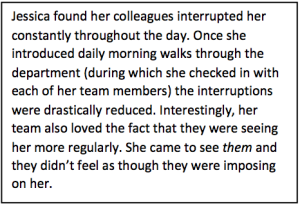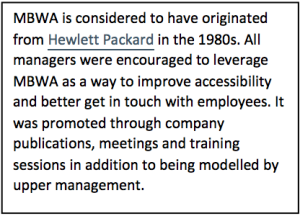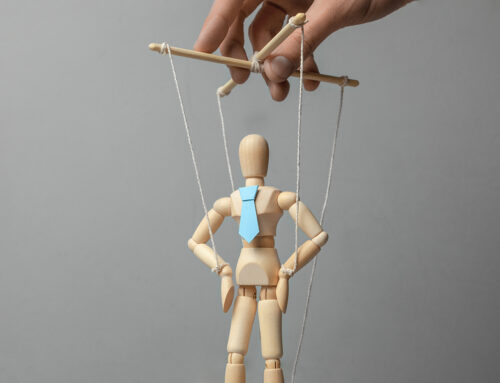As managers, we are often inundated with questions throughout the day. This is part of the job – we simply need to be accessible. However, this constant stream of drop-by visitors prevents us from having time to get our work done. What is the right balance?
Most managers schedule regular one-on-one meetings to manage some of these interruptions. These are critical meetings. However they don’t allow for the quick “please answer this so I can move on” kind of questions that pop up on a daily basis.
We need to supplement these regular meetings with something that addresses in-the-moment questions. Otherwise, we end up with interruptions all day long.
MBWA
The Management by Walk About (MBWA) approach is quite possibly the solution you are looking for. This is a simple technique that involves walking the halls and casually checking in with your team. Despite its informality, MBWA is an extremely effective management style.
There are five reasons why even the busiest managers should adopt the MBWA approach:
- MBWA makes you more accessible
One of the biggest criticisms faced by busy managers is that they are hard to track down. Adopting the MBWA technique resolves this by having you find them. They no longer experience the frustration of having to hunt you down. Also, when you go to their desk you might find them more comfortable and willing to speak freely about any challenges or issues.
- MBWA helps to address issues in the early (and easier) stages
MBWA helps to identify issues or obstacles in the early stages when they tend to be easier to manage. Simply asking about how projects are going helps you to see and hear things sooner (or possibly wouldn’t have otherwise heard about). It has been said that by the time a problem has reaches the manager’s office door, it has become too big for the employee to handle. We are also more likely to avoid issues from even occurring with this proactive, frequent management approach.
- MBWA reduces interruptions
Ironically, walking around to see our team may be the best way to deal with interruptions.
- MBWA improves team productivity
They say that we get the behaviour that we pay attention to. The Hawthorne Effect states that the mere act of showing people attention spurns them to better job performance. As Tom Peters said, “The simple act of paying positive attention to people has a great deal to do with productivity.” These informal check-ins may also give you a better sense of their workload which helps you better manage/balance future delegation opportunities across the team.
- MBWA makes people more engaged
Great leadership does not happen when sitting in front of a computer. Fully engaging your team requires you to connect with them. Mike Cloutier, former president of AstraZeneca Canada, makes MBWA part of his daily ritual. He finds that frequenting places like the on-site gym and learning center is a great way to connect with employees, particularly those he doesn’t encounter as frequently.
Use MBWA to provide positive attention by acknowledging some of the great things they are doing and provide some real-time, constructive feedback. “Employees who report receiving recognition & praise within the last seven days show increased productivity” according to Tom Rath.
That sums up the benefits of MBWA. What are your thoughts? How has this approach helped you and your team? We would love to hear from you in the comments.









This has helped me do my assignment and also know how I will work with my employees in future